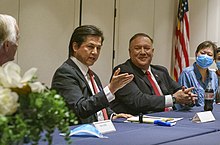Uyghur Americans
Uyghur Americans are Americans of Uyghur ethnicity. Most Uyghurs immigrated from Xinjiang to the United States from the late 1980s onwards, with a significant number arriving after July 2009.
 Uyghur American Erkin Sidick, a NASA engineer and a member of the Jet Propulsion Laboratory | |
| Total population | |
|---|---|
| 1,000-5,000[1][2] | |
| Regions with significant populations | |
| Washington D.C., New York, Los Angeles, San Francisco | |
| Languages | |
| Uyghur · American English · Mandarin Chinese | |
| Religion | |
| Predominantly Sunni Islam | |
| Related ethnic groups | |
| Uyghurs |
History
Uyghurs history in the United States dates back to the 1960s with the arrival of a small number of immigrants. In the late 20th century, after a series of Xinjiang conflicts, thousands of Uyghurs fled from their homeland of East Turkestan to Kazakhstan, Turkey, European countries, Canada and Australia, New Zealand and other countries. A 2010 estimate put the Uyghur population in the United States at one thousand, however the Uyghur American Association has said that more have moved to the United States in the 2010s because of the crackdown in China in July 2009. Several thousand Uyghurs are said to be living in the Washington, D.C. area, which has the largest population of Uyghurs in the United States. There are also small populations of Uyghurs in Los Angeles, New York, San Francisco and Houston.[2]
As of 2019, the Chinese government was reported to routinely carry out harassment and abuse of Uyghurs in the United States in an attempt to control the speech and actions of the estimated 1,500-5,000 persons of Uyghur ethnicity living in the United States.[1] Section 8 of the Uyghur Human Rights Policy Act of 2020 requires a report on "efforts to protect United States citizens and residents, including ethnic Uyghurs and Chinese nationals legally studying or working temporarily in the United States, who have experienced harassment or intimidation within the United States by officials or agents of the Government of the People’s Republic of China" to be produced within 90 days.
Organizations
As with other ethnic groups in the United States, Uyghur Americans also have several organizations. The most well-known organizations are Uyghur American Association,[3] a Washington D.C. based advocacy organization which was established in 1998 by a group of Uyghur overseas activists to raise the public awareness of the Uyghur people, the East Turkistan National Awakening Movement, a youth led organization which was set up by Uyghur graduate student Salih Hudayar in 2017[4] and East Turkistan Government in Exile, which was set up by Uyghur activist Anwar Yusuf Turani in 2004.
Notable people

- Rushan Abbas, activist
- Gulchehra Hoja (古丽恰克热·霍迦)
- Shohret Hoshur, journalist with Radio Free Asia
- Salih Hudayar, current Prime Minister of the East Turkistan Government-in-Exile
- Elnigar Iltebir, Director for China at the United States National Security Council
- Rebiya Kadeer, former President of the World Uyghur Congress
- Shoukhrat Mitalipov, stem cell researcher
- Anwar Yusuf Turani, political activist
- Nury Turkel, commissioner on the United States Commission on International Religious Freedom
- Mihrigul Tursun, former dentainee in the Xinjiang re-education camps
See also
References
- Omer Kanat (August 29, 2019). "China's Cross-Border Campaign to Terrorize Uyghur Americans". The Diplomat. Retrieved May 8, 2020.
- Judkis, Maura (March 3, 2017). "Is their crossroads cuisine 'the next big thing'? Uyghurs hope so". Washington Post.
- "About Uyghur American Association". www.uyghuramerican.org. Retrieved May 1, 2016.
- "About ETNAM – East Turkistan National Awakening Movement". nationalawakening.org. Retrieved January 20, 2019.